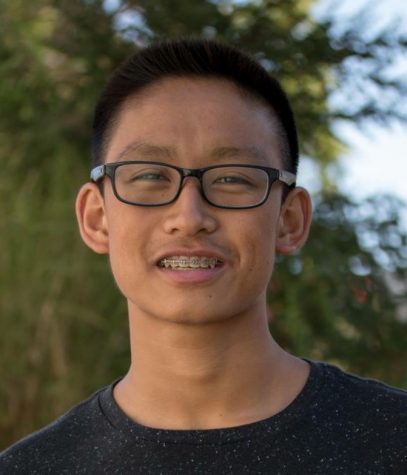Educational authorities respond to Trump executive order
March 8, 2017
President Donald Trump has signed a series of executive orders to restrict immigration, provoking fear and uncertainty among Dougherty students and prompting a variety of reactions from educational authorities at school, district, county and state levels.
Trump, who took office after his inauguration on Jan. 20, used his executive powers to implement changes in U.S. immigration policy in line with the rhetoric of his campaign. On Jan. 25, he signed Executive Orders 13767 and 13768, commencing construction on a southern border wall and expanding the powers of immigration officers to initiate deportation proceedings of non-citizens. Two days later, he signed a controversial ban on the admittance of foreign nationals from seven Muslim-majority countries, ordering a halt to the “entry into the United States … of such persons for 90 days from the date of this order.” Trump also instructed the Secretary of State to “suspend the US Refugee Admissions Program (USRAP) for 120 days,” effectively halting the resettlement of Syrian refugees.
Besides inciting passionate nationwide protests, Trump’s executive actions have resulted in palpable unease among members of Dougherty’s student body — many of whom are immigrants or the children of immigrants.
For instance, English Language Development (ELD) teacher Ms. Trista McCombs noted that the atmosphere in her classes responded to Trump’s rhetoric and actions.
“There was definitely tension … It wasn’t overbearing, but I can tell that they are aware and find it upsetting and wrong,” she said.
Sophomore Jerome (name changed for privacy) is a student in McCombs’s ELD class and hails from Syria, one of the seven countries listed among Trump’s executive order. His initial feelings surrounding the implementation of the travel ban included shock and fear.
“It’s not real, what is happening,” he said in disbelief. He added that several people he personally knew were afraid of deportation.
Of the approximately 50 students enrolled in the ELD program at Dougherty, most are international students. According to McCombs, the uncertainty and sense of disquiet were not just limited to those students whose countries of origin were among the seven listed in Trump’s executive order.
“My Chinese students are aware that this list is easy to expand,” stated McCombs. “They are extremely upset about it.”
“We are all immigrants … What is going to happen to us? Is it going to get worse?” questioned junior Connie Huang, another member of the ELD class.
Sophomore Symone Jhon Sayat stated, “I hate people crying over not seeing their families. America is opportunity for them, but now there are limits, rules.”
Although no one has been deported as a result of Trump’s executive order to bar immigration from the Middle East, thousands of people — including legal residents with green cards — were detained overnight or denied entry at airports across the nation after the order was signed on Jan. 27. The Trump administration justified the travel ban by citing concerns about terrorism and referencing past terrorist attacks, specifically 9/11. Critics were quick to point out that most of the recent prominent terrorist attacks — tragedies such as San Bernardino and Orlando — were perpetrated by homegrown extremists, some of whom were born in the United States. Detractors also emphasized the fact that the 9/11 attackers were from the countries of Lebanon, Egypt, Saudi Arabia and the United Arab Emirates, none of which were included in the executive order.
The sense of apprehension and worry present in the student body has not gone unnoticed by Dougherty’s administration. In response to current events, administration promotes an approach that espouses understanding, sympathy and support while still remaining calm and impartial.
“I want all students at Dougherty to know that this is an inclusive space … The bottom line is: we want all of our students to have access to education,” said Assistant Principal Megan Moilanen.
She emphasized the importance of administration and teachers “recognizing there is a reason to be nervous”, but that such figures will “help [affected students] get resources, separate fact from fiction and alleviate anxiety … It can feel scary, but there is reassurance.”
Besides recognizing and validating any feelings of fear among the student body, she restated administration and faculty’s roles in creating a welcoming space.
“Our doors are always open,” she added. “We are here as advocates, to ensure that students are safe and feel comfortable regardless of politics and their feelings about anything happening in the world today.”
She encouraged fearful students to talk to their counselors or their teachers.
“All teachers are willing to talk [to students],” she said, stating that faculty support is “a big part of our school culture.”
She did, however, make her opinion about the travel ban clear.
“As somebody who is an educator in a highly diverse educational facility … I profoundly believe our lives are enhanced by multicultural interaction, travel and experience. It’s what makes America such an incredible place,” she said, adding, “Any kind of potential limitation on travel and the mixing and melding of cultures is really disheartening.”
Moilanen has extensive experience as an educator who has worked with undocumented immigrants in Oakland.
“I support the DREAMers and DACA,” she stated, referring to federal policies that protect the rights of undocumented students. “Many students I’ve worked with have been DREAMers. I taught them. They were in my classroom. They came to the US as toddlers and babies. They are American. They describe themselves as Americans.”
Former president Barack Obama, despite his record-breaking deportation of 2.5 million undocumented immigrants, used his executive powers to protect undocumented students and young people with this Deferred Action for Childhood Arrivals (DACA) program. Obama’s executive order, while not providing a pathway to citizenship that the congressionally stymied DREAM Act would have provided, shields younger immigrants from deportation. These individuals must possess a clean criminal record and high school education to apply for DACA status. According to an issue brief from the American Council on Education, DACA “can be modified or rescinded at any time by the new administration” because it is an executive order rather than a law or regulation. As of yet, Donald Trump has not expressed an intention to end DACA protections for the 700,000 people protected by the program.
Moilanen maintains that fears surrounding a reversal of Obama’s executive order should be assuaged.
“If he [Trump] does something with DACA, it has nothing to do with K-12 schools … We are separate, very separate from immigration [policy], “ she stated. “We don’t have records of students’ immigration status … [they are] not in my files.”
In the case of parent-child separation, she stated that the school would work with Child Protective Services “if worst comes to worst.” Other hypothetical issues — such as a student missing school due to detainment at an airport — would be settled “on a case-by-case basis.”
Administration’s approach to the issue has been well-received by members of the ELD class.
“They are doing enough. They are not just supporting Muslim people, they are supporting everyone,” said Sayat.
Outside of school, resources such as the American Civil Liberties Union offer services to students who may be at risk under the new administration’s policies. Recently, the ACLU challenged Trump’s executive order restricting travel, leading to a temporary, court-ordered halt to the policy. A more partisan resource, United We Dream, offers both information and advocacy for immigrant youth.
Like the DVHS administration, the San Ramon Valley Unified School District is also focused on fostering a safe, inclusive and tolerant environment while still remaining aware of current events and of any fear these events may cause.
“The San Ramon Valley Unified School District is focused on ensuring that we are protecting students and preventing discrimination on our campuses … The safety of our students and staff is a top priority for us,” said SRVUSD Director of Communications & Community Relations Elizabeth Graswich in a written statement.
Specific, concrete responses include a “Words Matter Week”, partnering with the Anti-Defamation League (ADL) to implement the “No Place for Hate” program and “trainings for staff on inclusion and equity.”
“No Place for Hate” is an education initiative that aims to combat discrimination. According to the ADL, schools must build student-led coalitions “for identifying bias and bullying issues in the school” and participate in activities that address these issues in order to be designated as “No Place for Hate”.
SRVUSD is also “monitoring the seemingly constantly changing national conversation regarding immigration” and closely following current events.
These actions have been paralleled at the county level by the Contra Costa County Office of Education (CCCOE) — a body that oversees several school districts, including SRVUSD.
The CCCOE has provided a “post-election toolkit for educators” on their website, proclaiming that “all kids are our kids.” It contains a variety of resources and documents. One such document, a fact sheet co-authored by the Association of California School Administrators and the Oakland-based law firm Fagen Friedman & Fulfrost, was posted on Jan. 17 — just days before Trump’s inauguration. It offers information on the rights of students, staff and parents in regards to the disclosure of citizenship status and the presence of Immigration and Customs Enforcement (ICE) officials on campus. According to a 2013 study conducted by California’s Public Policy Institute, there are 77,500 undocumented immigrants living in Contra Costa County — roughly seven percent of the county’s population as recorded in that year’s census.
On a state level, California law dictates that resident undocumented students not only have the right to a K-12 education, but are required to attend in accordance with Section 48200 of the California Education Code. Cities such as Los Angeles and college campuses such as UC Berkeley have gained reputations as places of relative safety for undocumented immigrants. In addition to harboring millions of undocumented immigrants, the state has resettled more than 1,000 Syrian refugees, according to the California Public Policy Institute and the US State Department Refugee Admissions Processing System. In the face of dissent from Governor Jerry Brown, President Trump has vowed to revoke funding for these “sanctuary” cities and campuses through Sec. 2.(c) of Executive Order 13768, which states that “it is the policy of the executive branch to … [e]nsure that jurisdictions that fail to comply with applicable Federal law do not receive Federal funds”
Although Congress has failed to pass comprehensive immigration reform, several protections exist on a national level for undocumented students. A fact sheet written by the US Department of Justice and the Department of Education states that school districts are limited in the information they can require from students and their families. According to the document, school districts that “either prohibit or discourage … children from enrolling in schools because they or their parents/guardians are not US citizens or are undocumented may be in violation of Federal law.” Thus, although they are allowed to request students’ proof of residency, proof of age, social security numbers and racial and ethnic data, school districts may not require families to provide information regarding citizenship status or use any type of documentation to prevent enrollment based on such status. Additionally, the US Supreme Court decision in the 1982 case Plyler v. Doe prohibits states from denying public education based on a student’s citizenship status.
With Trump’s nominees to lead these two departments recently confirmed by the GOP-controlled Senate, it is unclear if and how these entrenched federal protections will change. Although he has vowed to cut funding from so-called “sanctuary cities” if their leaders do not to comply with his policies, it is unclear if Trump would attempt to defund “sanctuary campuses” as well. Currently, the president’s stance on removing existing legal protections in the education system for undocumented students remains ill-defined.
Ultimately, in the face of this uncertainty and unease over the future of immigration policy, Dougherty administration holds a resolute sense of faith and calm.
“Every educator on this campus wants to ensure equitable access [to education],” said Moilanen. “Presidents and policies come and go, but public education … it’s one of our oldest institutions.”



